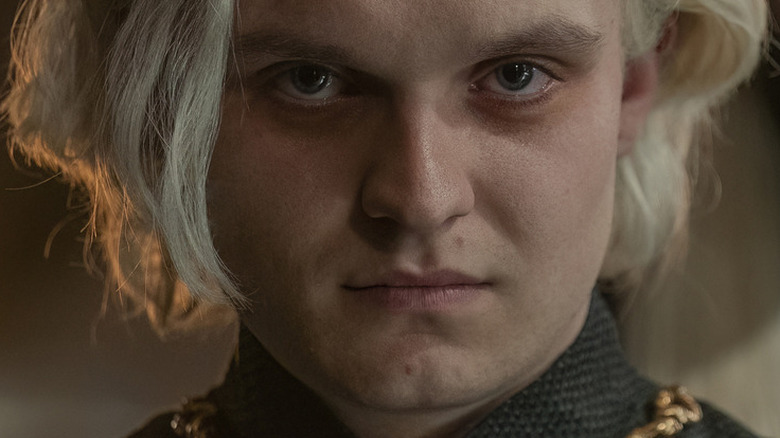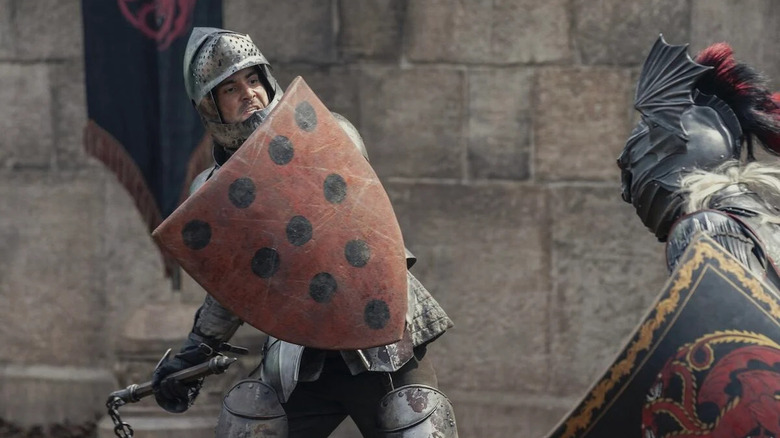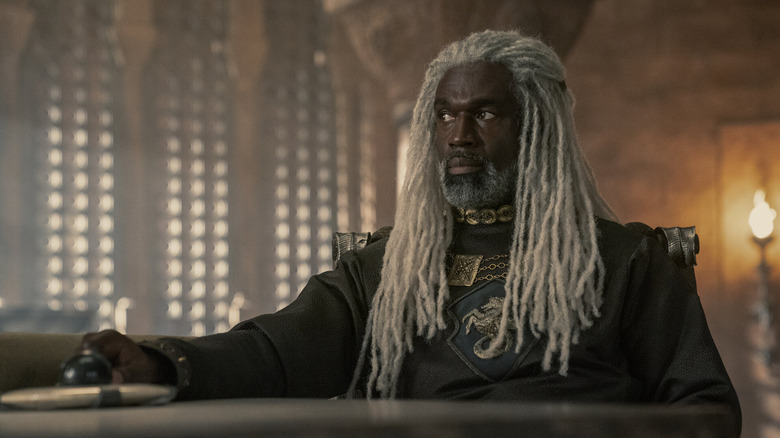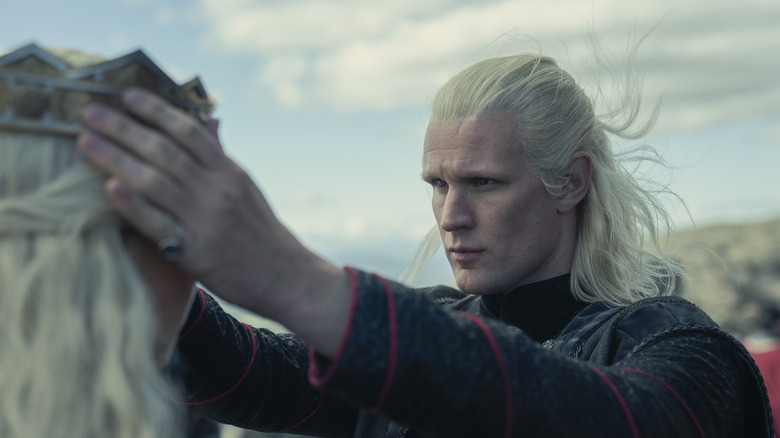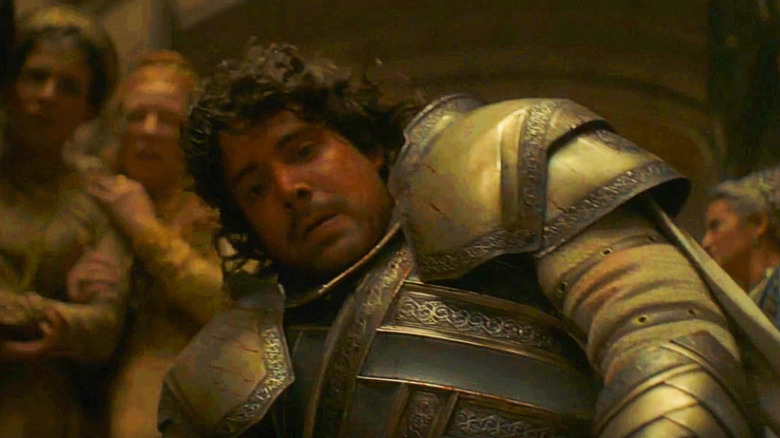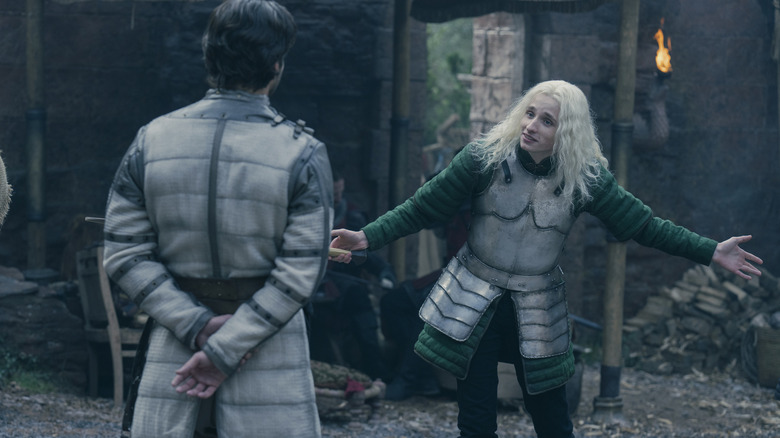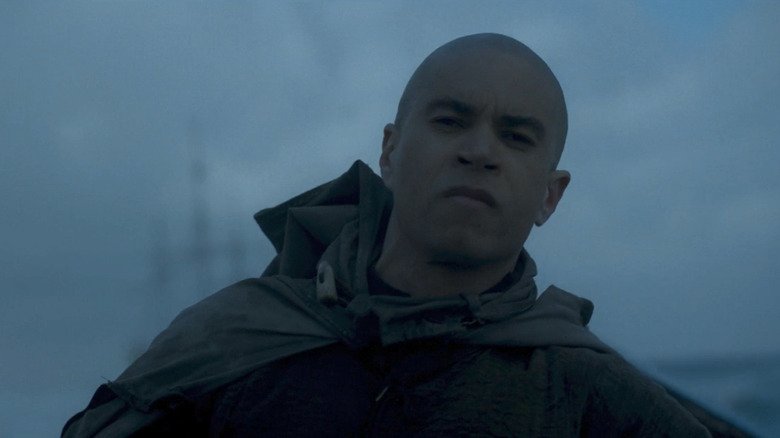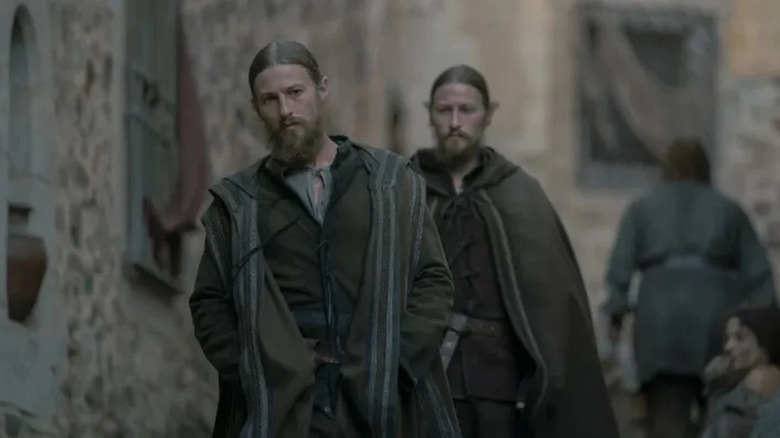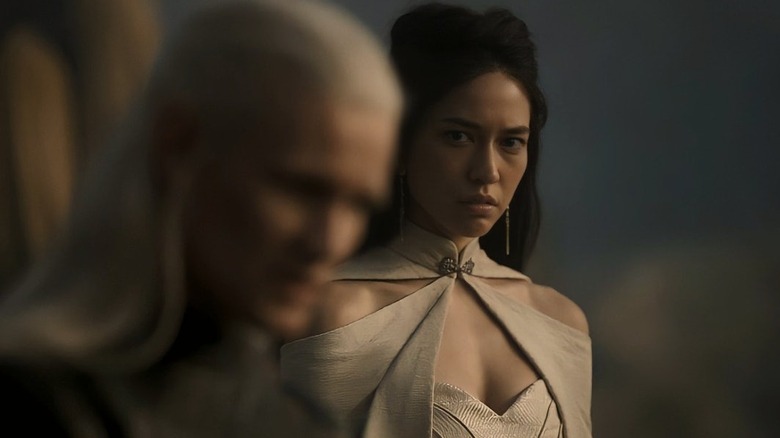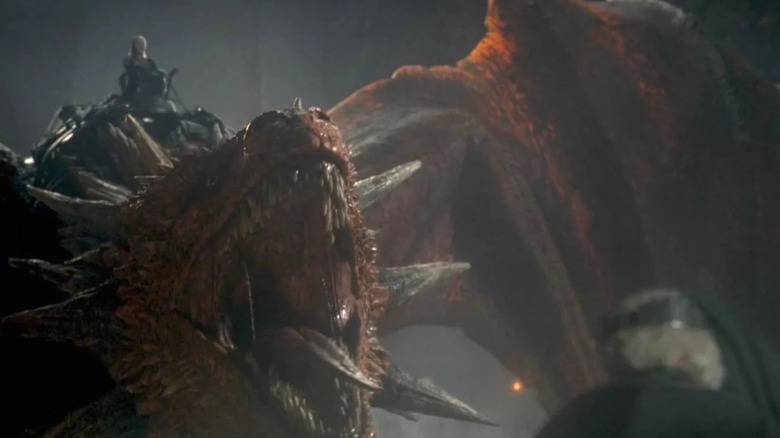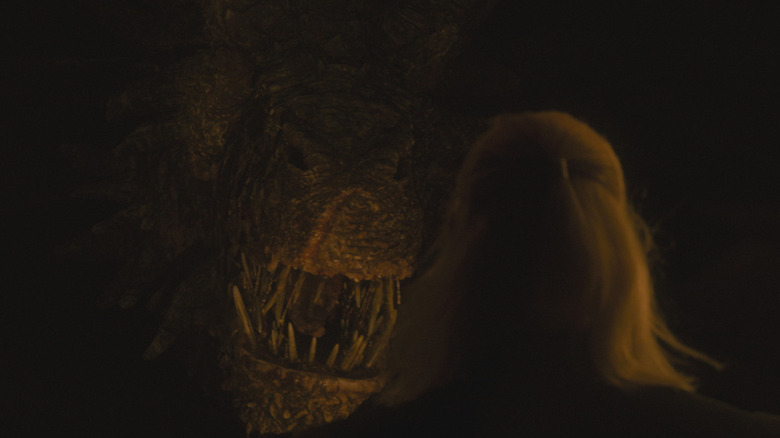House Of The Dragon's Most Confusing Moments Explained
For eight years, part of the pleasure of watching "Game of Thrones" was theorizing about some of the show's big reveals. What was Jon Snow's real identity? Who was the Prince Who Was Promised? Who would win the game of thrones, and who would die in the process? As an intellectual property, "Game of Thrones" contains as much subtext as text. Vital parts of the story are sometimes left unsaid. Meanings are represented in objects and expressions. It's easy to misinterpret — or to miss altogether — the contextual clues the series wants viewers to pick up on.
"House of the Dragon" is much the same, but with an added layer of unreliability. Because the source material, George R.R. Martin's "Fire & Blood," is written in the style of a fallible history text based on information given by long-dead sources, book readers can never be sure that what they think is going to happen will actually play out on the screen in "House of the Dragon." The prequel series races through its timeline at breakneck speed compared to "Game of Thrones," so audiences have had to keep up or get lost along the way. And, as is the case in all of George R.R. Martin's stories, there are a lot of people and places to commit to memory (not to mention all the dragons).
From character motivations and casting changes to twisty diversions from the book, we're explaining the most confusing moments in "House of the Dragon" Season 1. Spoilers ahead.
How do tournaments work?
Episode 1 is packed with pomp, circumstance, spectacle, and extreme violence. Nothing compares to Aemma's brutal labor, but the tournament that King Viserys holds to celebrate the coming of his son comes close.
Some fans were confused as to why some knights in the tourney battled to the death while others conceded and lived. It is true that most of the tournaments that take place in Martin's "A Song of Ice and Fire" series end without loss of life. The "Game of Thrones" universe isn't strictly based on medieval European history, but it definitely draws inspiration from its culture. Real tournaments could turn deadly, and though they were fought between supposed noblemen, they were also opportunities to increase one's wealth and status through theft and foul play when one could get away with it.
The show has three reasons for depicting the tourney so graphically. Shots of the knights' bodily harm are intercut with shots of Aemma's doomed delivery to emphasize the violence inherent in both. Princess Rhaenys remarks that the young combatants are "as green as summer grass" and adds that "none have known real war. Their lords sent them to the tourney field with fists full of steel and balls full of seed, and we expect them to act with honor and grace?" Finally, the fact that King Viserys allows three knights to die for the crowd's entertainment shows how little control he actually has over his people. In short, these ultra-violent jousts and melees show the realm is sick of peace and ready for war.
What's the deal with the Triarchy?
King Viserys calls his rebellious teenage daughter Rhaenyra his political problem, but the actual political problem that's plaguing the small council all season is that of the insurgent Triarchy. They get a shout out in Episode 1 when Corlys urges the King not to "give them much latitude," and by Episode 2, they've taken four ships, including one of the Sea Snake's vessels. Viewers understand that the Crabfeeder is their big bad and that they have something to do with trade routes, but the show glosses over most of the book's details about this constant thorn in the Kingdom's side.
The Triarchy is the name given to Myr, Lys, and Tyrosh, three former Valyrian colonies. Corlys tells Viserys that they're "ridding the Stepstones of its pirate infestation." The King was probably thinking the same thing that audiences were: Isn't that a good thing? In "Fire & Blood," it is, at least for a little while. But the Triarchy, led by Craghas Drahar (aka the Crabfeeder) starts getting too greedy and power hungry for Westeros' taste, especially in the opinion of a merchants like Corlys, who need to pass through the Narrow Sea and don't want to pay their tolls or risk their attacks.
Daemon, who is without a seat of his own after Rhaenyra is named Princess of Dragonstone, is interested in joining forces with Corlys because he can fashion himself as the ruler of the islands after they conquer the territory. He has a close relationship with Pentos (where he and Laena are staying in Episode 6), which borders Myr, because they want to keep their neighbor in check. In short, the Triarchy is a political alliance between three of the Free Cities that gets too big for its boots.
What was Daemon's plan in taking Rhaenyra to the pleasure house?
Audiences may have been scandalized by a salacious moment in Episode 4, which distracted from some important character motivations. After having rebuffed her suitors, Rhaenyra finds a bag containing peasant clothes and a map of a secret passageway leading from her quarters. She changes, follows the directions, and finds her uncle Daemon waiting for her in a cloak. Both disguised, Daemon takes the teenage Rhaenyra on a tour of Flea Bottom, ending in a pleasure house on the Street of Silk. He begins to seduce her, but seems surprised that she's into it, and pulls away. The implication in the first half of the season is that Daemon suffers from impotence, and he either can't or won't complete the act. Rhaenyra runs back to Ser Criston and forces him to come into her room by stealing his helm.
We know Rhaenyra's motivation in these scenes. She's always had a thing for Daemon and she's behaving like a repressed 18 year old girl. Daemon's motivation is trickier to decipher, but he almost certainly meant to get caught. Notably, he and Rhaenyra cover their heads as they walk through the streets of King's Landing, but before they enter the pleasure house, he removes her hat and his hood, revealing their unmistakable white-blonde hair. One of Mysaria's spies runs and tells Otto, who in turn tells the King. The King questions Daemon, who lies about what went down — though it's not true, Daemon takes credit for having deflowered the princess and says, "Wed her to me. I'll take her as she is." This was his ultimate goal: Being the husband of the queen is as close to power as Daemon could ever hope to be.
Why did Criston beat Joffrey to death?
Episode 5 is the chapter in which Criston Cole goes from being Rhaenyra's dreamy Dornish boyfriend to one of the most reprehensible characters in "House of the Dragon," which is really saying something for a show with so much moral gray area. At Rhaenyra and Laenor's pre-wedding feast, the groom's lover, Ser Joffrey Lonmouth, guesses that the knight might be the bride's lover. In a slightly coded way, he approaches Ser Criston about their mutual interest in Rhaenyra and Laenor's relationship. Moments later, Criston beats Joffrey to a bloody pulp in the middle of the dance floor as fights break out all around them and onlookers stand aghast.
Why did Criston snap? In the book, he doesn't. Criston kills Joffrey at the wedding tourney with his morningstar. The show's version is much more intentional. Criston continues to rain fists down upon Joffrey's head long after he's dead. Many fans assumed the reason was homophobia. Like Alicent, Criston reveals himself to be something of a religious hypocrite, claiming piety while also being awful. In subsequent episodes, Criston mocks Laenor's sexuality, so his sickening assault appears to be a hate crime, but it is also an act of self-preservation. Alicent didn't castrate him, kill him, or send him to the Wall for breaking his Kingsguard vows not to marry or take lovers (let alone the princess and heir), but if word of his tryst with Rhaenyra got out, someone else might push for that. Still, it's strange and indefensible for a member of the Kingsguard to have murdered a member of the groom's house without consequence.
Why recast some characters and not others?
The lead-up to the Targaryen civil war known as the Dance of the Dragons takes about twenty years, but the Dance itself unfolds in only a few. That means Season 1, which sets the teams for the war, makes three pretty sizable time jumps (and that's not including the prologue). Between Episode 2 and Episode 3, roughly three years pass. Between Episode 5 and Episode 6, another 10 years go by. Between Episode 7 and Episode 8 are six more years. Many major characters are played by the same actors throughout. Others are played by two actors, and some are played by three.
Obviously, this has to do with age. Characters who appear as children — especially small children — required dual or triple casting. Fans weren't really confused by the idea of young and adult Rhaenyra and Alicent, though some objected to the fact that the women had to be aged up with new actors while the men did not. However, this is not entirely true. While Criston is apparently (and unfortunately) all but immortal, Laenor was replaced in Episode 6's fast-forward along with the princess and the queen.
The triple casting of Laena seemed to confuse viewers (especially non-book readers) the most. She's played by one actor at 12, another at 15 in Episode 5, and a third in Episode 7. Since we spend little time with Laena, it's pretty hard to keep track. The reason for this is her age when she gets introduced — it may be confusing, but she goes from a tween to a teen to a young adult, so changing up the actor was deemed necessary. However, there's no explaining why the 20-year-old King Aegon looks younger than the 14-year-old version, while Aemond looks dramatically older.
Were Daemon and Rhaenyra in on Laenor's escape?
In "Fire & Blood," Qarl slays Laenor at a market in Spicetown in front of witnesses, and it's suggested that Daemon may have paid him to do it so he could finally marry Rhaenyra. At one point, it looks like this will also happen on the show, but "House of the Dragon" reveals what really happened.
Rhaenyra and Daemon know Laenor will have to die for them to wed. Daemon approaches Qarl and tells him he could start a new life across the sea for the right price. Laenor and Qarl draw swords, Corlys and Rhaenys discover a body in their fireplace, and a rowboat is waiting on the shore. Someone runs to it. Book readers may have expected it to be Daemon, there to kill Qarl and preserve his secret. Instead, we see Laenor with a shaved head, who rows away with his lover.
Though the editing is meant to be tricky, the writers actually gave us clues regarding the foursome's plan. First, Rhaenyra cryptically tells Daemon that fire took away their loves (Harwin and Laena), but the sea offers an escape (for Laenor and Qarl). When Daemon propositions Qarl, he insists there must be witnesses. A public fight would put blame on Qarl instead of Daemon, who has the stronger motive, yet we know that Daemon doesn't care about his reputation. Finally, Daemon snaps the neck of a servant on the stairs. That's the body that's swapped into the hearth to pull the whole thing off.
We know Rhaenyra and Daemon are aware of the escape because, on two occasions, they speak to each other about how people think Laenor is dead. It may come back to haunt them should Laenor ever return, but for the time being, the plan has paid off.
Arryk and Erryk
It's much easier to tell these two characters apart in the book than it is on the screen. Arryk and Erryk Cargyll are members of the Kingsguard and twins so identical that, canonically, no one can tell them apart (which becomes an important plot point). It's not just their faces and matching hairstyles; when said out loud, their names are practically indistinguishable. The show didn't do viewers any favors by waiting to introduce Ser Erryk (fleetingly) in Episode 8 before the twins became major players in Episode 9. If you couldn't keep these two straight — or just didn't know who they were in the first place — you aren't alone.
Ser Erryk is the guard appointed to protect Aegon. He's the one who informs Queen Alicent about the prince's rape of Diana. It's Erryk who tells Otto that he doesn't know where Aegon is, explaining, "He exploits his authority to order me away, and then he evades me, my Lord." But Erryk does know where to find him. He's familiar with the child fighting arenas, since Aegon frequents them. Because Erryk understands how insidious a ruler Aegon would be, he breaks Rhaenys free from her room and steals Viserys' crown for Rhaenyra. It's Erryk who arrives at Dragonstone to bend the knee and recite his Queensguard oath. Arryk, meanwhile, is the twin who fights against Criston Cole and who remains loyal to Otto Hightower and the Greens. It's Arryk who stands behind Otto on the bridge when the Hand comes to deliver Alicent and Aegon's terms.
What happened to Talia and Mysaria?
Mysaria pulls herself up by her own bootstraps: She goes from Daemon's mistress to Westerosi bed and breakfast proprietor to unofficial mistress of whispers. She didn't seem too pleased with Daemon for inventing a pregnancy and putting her in harm's way in Episode 2, but we don't really know where they stand at this stage. Daemon insists in Episode 10 that he has friends back in King's Landing, and she might well be one of them. But in Episode 9, we learn that her web of spies extends to the palace. Talia lights a candelabra to signal the king's death then finds Aegon and hides him (with his willing cooperation, it seems) under the altar at the Sept.
When Otto comes looking for the king-to-be, Mysaria unveils herself as the White Worm. Otto has to recognize her from the showdown on the bridge in Episode 2, yet he knows her information has always proved itself to be correct, so she's likely built trust enough to ask for something in return for Aegon's location: An end to the child fighting pits. However, Larys — Alicent's unofficial master of whispers — susses out that the Hand has a gossip bug of his own. In exchange for a glimpse of the Queen's feet (the guy has a kink), he says he'll take care of it.
We can infer that, because Talia was imprisoned along with the other servants to keep word of the king's death from getting out, that Lord Confessor Larys Strong (his official job title) tortured the captive lady's maid and traced the web back to Mysaria. It's her property that's burning near the end of Episode 9, but we haven't seen the bodies of the White Worm or her palace informant. The former is probably still alive.
Why does Rhaenys spare the lives of the Greens?
It surprised everyone when Princess Rhaenys, on the back of Meleys the Red Queen, burst through the floor of the Dragonpit to cause chaos at Aegon II's coronation. Viewers didn't see it coming, nor did book readers, since this doesn't happen in "Fire & Blood." It makes for one of the coolest visuals in "House of the Dragon," but, narratively, this show-stopping moment didn't make a ton of sense.
For one thing, audiences were kind of disturbed that Rhaenys — who seems like one of the most moral and grounded characters on the show — would so carelessly kill hundreds if not thousands of innocent bystanders with her grand entrance. The Dragonpit holds 80,000 people and it was pretty full when Aegon was thrusting his shiny new sword into the air. Given that the Queen Who Never Was is apparently fine with collateral damage, it was equally head-scratching to some fans that she didn't just "dracarys" the Greens then and there. She knows war is on the horizon, so by leaving Aegon II alive, she and her family remain vulnerable.
Co-showrunner Ryan Condal gave his perspective: Rhaenys didn't want to murder another mother (though surely some of those peasants in attendance were mothers?), and she didn't feel it was her place to start (or prevent?) the Dance of the Dragons. It still doesn't make much sense, but that's the official explanation. The truth, it seems, is that they just thought it would look cool. "We needed a penultimate scene, so we tried to come up with: What's the worst thing that could possibly happen at the coronation?" co-showrunner Miguel Sapochnik said. "And [we] realized that it was a dragon to be let loose."
Which dragon is Daemon singing to?
It's easier to tell the dragons apart when they're younger. Fans didn't have too much trouble distinguishing between Syrax and Caraxes or Seasmoke and Vermax. It's harder to tell who is who in wide shots with multiple dragons flying. In case you were wondering: Seasmoke and Meleys take Laenor and Rhaenys to the wedding, while Dreamfyre and Sunfyre are hovering over the ship when Vhagar joins them. Speaking of Vhagar, it seems it's harder to tell dragon from dragon once they're of a certain age. Vhagar is more than 150 years old, the oldest and largest dragon in Westeros. She may have been beautiful once, but by the time Aemond is riding her, she's starting to show her age.
When Daemon goes to the Dragonmont, he attempts to make a connection with an old, brown, and very large dragon. If you went to Twitter after the episode aired, you would have seen that some viewers thought that this was Vhagar and suspected Daemon was inciting her to violence. They can be forgiven for the mistake, as it's very dark and the dragon in question is very big. The prolific fire-breather to whom Daemon is crooning is actually Vermithor, the second oldest, second biggest dragon in Westeros and the former mount of King Jaehaerys.
Daemon mentions Vermithor (as well as Silverwing, Queen Alysanne's dragon) by name at the Painted Table, but he doesn't address Vermithor as such when he tip-toes up to him shortly thereafter. Other viewers thought that perhaps Daemon was about to trade in Caraxes for a more classic model. We don't want to spoil too much, but what the Rogue Prince is really doing here is prepping unclaimed dragons for new riders to give the Blacks an edge over the Greens in the civil war.
